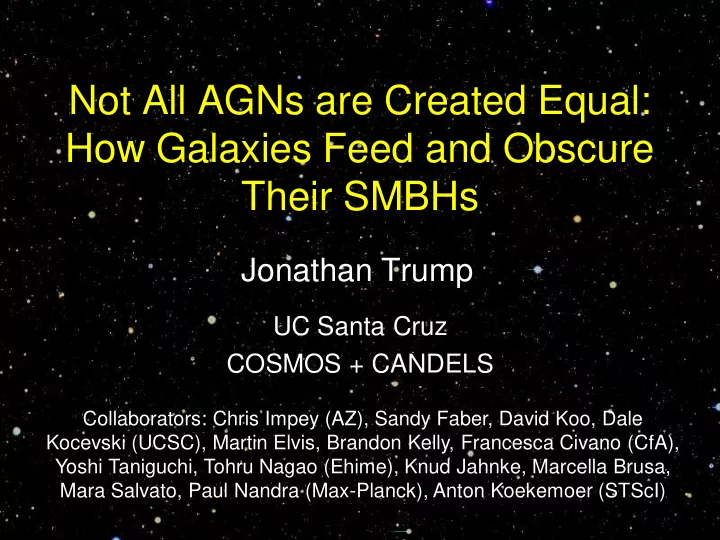

Not All AGNs are Created Equal: How Galaxies Feed and Obscure Their SMBHs Jonathan Trump UC Santa Cruz COSMOS + CANDELS Collaborators: Chris Impey (AZ), Sandy Faber, David Koo, Dale Kocevski (UCSC), Martin Elvis, Brandon Kelly, Francesca Civano (CfA), Yoshi Taniguchi, Tohru Nagao (Ehime), Knud Jahnke, Marcella Brusa, Mara Salvato, Paul Nandra (Max-Planck), Anton Koekemoer (STScI)
A Paradigm for SMBH Activity • What ignites the AGN phase? – Galaxy mergers? (Sanders+88, Hopkins+06) – Isolated disks? (Hopkins & Hernquist 06, Bournaud+11) s • Why do AGN look so different? – Broad / narrow lines, luminosity, SED vary widely – Caused by different obscuration, or accretion physics? – Governed by host? Is there a Unified Model to describe different active galaxies???
The Historical AGN “Unified Model” (Antonnucci 93) Orientation explains: • Luminous / Faint • Obscuration • Type 1 (BL) / 2 (NL) • Reflected BLR in spectropolarimetry But many objects don’t fit! Many Type 2’s have little X-ray absorption (Trouille+09), no IR torus (Trump+09c,11b) & no reflected BLR (Tran 01,03) from Urry & Padovani 1995
AGN Fueling (unobscured only: N H <10 22 cm 2 ) • L int /L Edd : accretion rate • With L disk /L X , E peak of disk, X-ray slope Type 1 AGN Type 2 AGN Opt. dull AGN Trump+11b
AGN Fueling Different L int /L Edd for Broad-Line AGN unobscured Type 1/2 Unobscured Narrow-Line & Lineless AGN
AGN Fueling • Disk gets brighter & hotter as accretion rate increases (difference is >3 σ )
Accretion Rate and Radio Jets • Weakly accreting AGN are more radio-loud! • Weak AGN may be more important for radio-mode feedback (e.g. heating cluster cores, IGM enrichment)
What about Obscured AGN? High L int /L Edd like unobscured Type 1s (using L int = 8L 6 μ m , Richards+06)
Accretion in AGN Unification Trump+11b L I /L Edd > 0.01 L I /L Edd < 0.01
Two Axes in AGN Unification N H ~10 22 cm -2 Obscured Quasars Type 2s Accretion Rate Do AGN with different acc rate / obscuration have different hosts? L/L Edd ~0.01 “Naked” Type 2s Optically dull AGNs LINERs Obscuration
Do Mergers feed Quasars? • ULIRG AGNs (Sanders+88, Kartaltepe+10 ) • Hard X-ray (Swift) AGN (Koss+10) • BALQSOs (Urrutia+08) All these are obscured, rapidly accreting, and local
X-ray AGNs are not more likely to be in Mergers from Cisternas+10 Kocevski+11 • Not in mergers! • (Grogin+05, Pierce+07, Gabor+09 , Cisternas+10 ) • Is this because the AGN only appears after the merger is relaxed?
Are Active Galaxies Disks or Spheroids? • AGNs are frequently in disks! (e.g. Schawinski+11) • Disks are unlikely to have recent merger (but see Robertson+06) • But, AGNs are more typically Kocevski+11 in spheroids… and spheroid fraction increases with L AGN Weak X-ray AGNs in disks, Luminous X-ray AGNs in spheroids
AGN Host Types N H ~10 22 cm -2 Obscured Quasars, Type 2s, Accretion Rate Spheroids Mergers L/L Edd ~0.01 “Naked” Type 2s, Disks Optically dull AGNs / LINERS, dead spheroids Obscuration
How important is disk fueling? • More disks than Cisternas+10 predicted (~40 × ) disk fractions • QSOs (& mergers?) still dominate XLF Kocevski+11 disk frac >50% <50% disks >50% <50% disks disks disks XLF from Aird+10 Hopkins & Hernquist 06 model
QSO hosts are S0 / green valley, not red dead ellipticals • QSO host galaxies from SDSS, with QSO removed from phot. • Trump & Hsu in prep.
AGN presence in low-mass galaxies at z~2 • WFC3 slitless grism Inner 34 WFC3 • z~2 galaxies galaxies typically have Outer AGN ratios in stacked core! • Similar result from Wright+10 (1 galaxy) z~0 comparison z~0.6 comparison (Kauffmann+03) (Yan+11) • Also see recent Aird+11 paper Trump+11c (submitted)
Summary Accretion Rate: new axis in AGN Unification • Low accretion rate: ADAF at inner radii • ADAF: radio-loud, cooler + weaker disk, different IR, BLR disappears • Rapid accretion / obscured -> merger • Rapid accretion / unobscured -> spheroid • Weak accretion (“naked” Type 2) -> disk
Recommend
More recommend